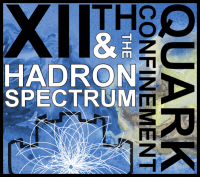Speaker
Description
Long-range multiplicity correlations in intervals separated in pseudorapidity and azimuth are studied in the framework of string fusion approach.
We applied a Monte Carlo model [1,2], in which the string configurations in the transverse plane and rapidity are simulating event-by-event.
We assumed that the azimuthal anisotropy of particle production is caused by parton energy loss travelling trough the media formed by clusters of fused strings [3-5]:
$\Delta p_t/\Delta x = - \alpha ( p_t \sqrt { \eta } )^{2/3} $,
where $ \eta $ is a string density.
An additional source of the anisotropy is related to the strong resonances decays.
This approach provides non-zero values of elliptic and higher flows in Pb-Pb and p-Pb collisions at LHC energies. The obtained results are compared with experimental data.
The author acknowledges Saint-Petersburg State University for the research grant 11.38.197.2014.
[1] V. N. Kovalenko, Phys. Atom. Nucl. 76, 1189 (2013), arXiv:1211.6209 [hep-ph].
[2] V. Kovalenko, V. Vechernin, PoS (Baldin ISHEPP XXI) 077, arXiv:1212.2590 [nucl-th], 2012.
[3] M. A. Braun, C. Pajares, Eur. Phys. J. C 71, 1558 (2011).
[4] M. A. Braun, C. Pajares, V. V. Vechernin, Nucl. Phys. A 906, 14 (2013).
[5] M. A. Braun, C. Pajares, V. V. Vechernin, Eur. Phys. J A 51, 44 (2015).
Summary
The results on the theoretical modeling of azimuthal anisotropy of long-range correlations at LHC energies in string fusion approach will be presented.




